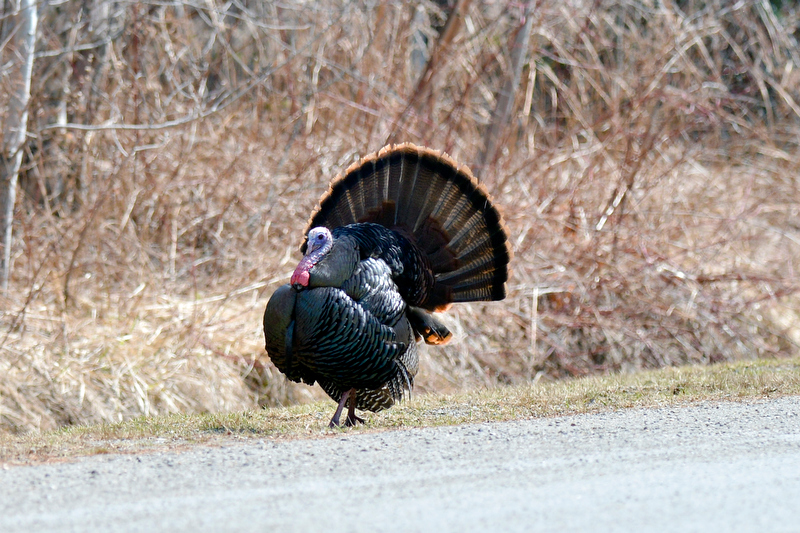AUGUSTA — Due to the impact of this year's severe winter in northern Maine, the Maine Department of Inland Fisheries and Wildlife has suspended the spring wild turkey hunt in portions of northern Maine, specifically Wildlife Management Districts 1-6. This covers approximately the top third of the state, from Baxter State Park north to Fort Kent. The spring turkey season remains unchanged in all other areas of the state.
"Late winter can be the most critical period for wild turkeys, and unfortunately March of 2014 has been challenging for turkeys in northern Maine," said IFW Commissioner Chandler Woodcock. In fact, the National Weather Service ranked March 2014 in northern Maine as the third snowiest March on record.
"This winter has taken a toll on younger wild turkeys, including hens. A spring hunting season in addition to the severe winter could impact not only this turkey season, but future seasons as well," said Woodcock.
IFW wildlife biologists believe that northern Maine's wild turkey population has likely sustained above-average winter mortality rates. Perhaps more significantly, much of northern Maine is still blanketed in snow. The region's wild turkey population is more vulnerable to severe winters because the birds are not as well established there as elsewhere in the state.
"Wild turkeys breed in April and May, and there is still over 2 feet of snow in the northern Maine woods, and 80 percent of our fields are snow-covered, making nesting conditions extremely difficult for turkeys," said IFW Wildlife Biologist Rich Hoppe.
Wild turkeys nest on the ground at the base of trees or near brush piles. Late spring snow, excessive water and below normal temperatures will delay nesting, potentially impacting overall nesting success.
A Maine State Police trooper escaped injury April 17, when a wild turkey flew into the windshield of his cruiser, according to Steve McCausland, spokesman for the state Department of Public Safety. Trooper Tucker Bonnevie reported seeing a flock of turkeys in the median of I-95 in Plymouth Thursday around 6:30 a.m., when one of the birds took flight and flew into his windshield. The impact left a large indent in the front windshield of Bonnevie's cruiser, on the driver's side, and shattered the safety glass. Bonnevie was traveling along the southbound lanes when the accident occurred, and McCausland said damage was confied to the cruiser's windshield. Driver's should always use caution when driving and encountering animals, including wild turkeys, along the side of the road, all of which can act unpredictably.
Historically, wild turkeys existed in significant numbers in York and Cumberland counties, and perhaps in lower numbers eastward to Hancock County. From the time of European settlement until 1880, agricultural practices intensified, leading to a 90 percent conversion of southern Maine forests to farmland. Reduction of forestland coupled with unrestricted hunting led to the extirpation of Maine's wild turkeys in the early 1800s. The abandonment of many farms in the late 1800s allowed farmlands to slowly revert back to forest. By 1970, only 15 percent of York and Cumberland counties remained farmland. The reversion of thousands of acres of cleared land to woodland habitat made conditions ideal for reestablishing turkeys into their former range. Although Maine's wild turkey population had disappeared more than 100 years ago, in 1977 and 1978 IFW biologists began a wild turkey reintroduction program by releasing 41 of the birds donated by Vermont biologists. It seems almost incomprehensible today that southern and central Maine's booming wild turkey population began with a wing and prayer 37-years ago with those Vermont turkeys. In exchange, Maine donated American pine marten to Vermont.
By the early 1980s, York County's turkey population had become large enough to serve as a source of birds for new release sites in Maine. In the spring of 1982, to rebuild turkey populations in Waldo County, 33 birds were captured in York County and released in the Midcoast region. In the winter of 1984, 19 additional birds were captured in York County and released in Hancock County, but poaching lead to the demise of these birds. During the winters of 1987 and 1988, IFW biologists, Maine Chapter of the National Wild Turkey Federation volunteers and Connecticut Department of Environmental Protection personnel trapped 70 wild turkeys in Connecticut. The birds were trucked and released in Maine to again augment the turkey population and to improve its genetic stock.
Stewardship and partnerships with outdoor groups and landowners has helped increase the range of wild turkeys throughout all Maine counties, including the northern region. This past fall, IFW expanded turkey hunting opportunities to include the entire state.
The restoration of the wild turkeys may be the single greatest wildlife conservation success story in U.S. history. The growth of Maine's turkey population elicits no arguments, except from a few dairy farmers in Knox County, where turkeys apparently forget to act wild by occasionally eat grain side-by-side with cows — and inside their barns!
Although an exact figure of Maine's current turkey population is anyone's guess, what is known is this: By the early 1900s, the continent's wild turkey population had been reduced to an estimated 30,000. Today, the National Wild Turkey Federation estimates that 7 million turkeys display, gobble, trot, cluck, scratch and fly across the U.S. and parts of Canada. And in Maine, the large game birds can be seen in the spruce-fir forests in the Allagash Region, a region of Maine that was not historically occupied by turkeys. This winter notwithstanding, the turkey's remarkable range expansion into northern Maine is the definition of ecological success. The birds are proving that they are almost as hardy as northern Mainers.
Ron Joseph is a retired Maine wildlife biologist. He lives in Camden.





























